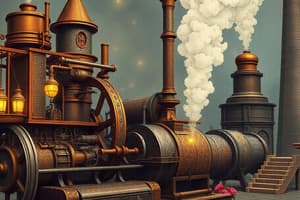Podcast
Questions and Answers
À la fin de quel siècle le travail n'est plus seulement manuel et devient de plus en plus mécanique ?
À la fin de quel siècle le travail n'est plus seulement manuel et devient de plus en plus mécanique ?
À la fin du XVIIIème siècle.
Quel type de machine est décrit comme étant capable d'actionner à elle seule d'autres machines ?
Quel type de machine est décrit comme étant capable d'actionner à elle seule d'autres machines ?
La machine à vapeur.
Par qui et en quelle année la machine à vapeur a-t-elle été améliorée ?
Par qui et en quelle année la machine à vapeur a-t-elle été améliorée ?
Par l'Écossais James Watt en 1769.
Avec quoi fonctionne la machine à vapeur améliorée par James Watt ?
Avec quoi fonctionne la machine à vapeur améliorée par James Watt ?
Quel changement majeur dans les conditions de travail le regroupement des machines dans des ateliers et usines a-t-il provoqué ?
Quel changement majeur dans les conditions de travail le regroupement des machines dans des ateliers et usines a-t-il provoqué ?
Quel développement, utilisant les mêmes principes que la machine à vapeur de Watt, a rendu possible la réduction des distances ?
Quel développement, utilisant les mêmes principes que la machine à vapeur de Watt, a rendu possible la réduction des distances ?
Qu'est-ce que l'industrialisation ?
Qu'est-ce que l'industrialisation ?
Quel pays est considéré comme le berceau de la révolution industrielle ?
Quel pays est considéré comme le berceau de la révolution industrielle ?
Comment l'industrialisation s'est-elle déroulée dans le reste de l'Europe par rapport à l'Angleterre ?
Comment l'industrialisation s'est-elle déroulée dans le reste de l'Europe par rapport à l'Angleterre ?
Flashcards
Steam engine
Steam engine
Machine that can operate other machines.
James Watt
James Watt
Scottish inventor who improved the steam engine in 1769.
Technical revolution
Technical revolution
A major shift in work conditions due to machines.
Factory production
Factory production
Signup and view all the flashcards
Industrialization
Industrialization
Signup and view all the flashcards
Industrialiszation definition
Industrialiszation definition
Signup and view all the flashcards
England's role
England's role
Signup and view all the flashcards
Study Notes
- By the end of the 18th century, work was no longer solely manual, becoming increasingly mechanical
- The steam engine is a machine that can power other machines on its own
- The steam engine was improved by the Scottish inventor James Watt
- James Watt improved the steam engine in 1769
- This machine operated using coal, sparking a technical revolution that transformed working conditions
- Machines were gathered in workshops and factories, leading to larger quantities being produced at lower costs
- Industrialization was equally enabled by the development of the steam locomotive
- Steam locomotives operate using coal and according to the principles of Watt's machine
- This invention reduced distances and increased speed
Industrialization
- Shift from craftsmanship (an artisan performing manual labor) to industry (workers in factories operating machines)
Europe's Entry into Industrialization
- England is the birthplace of the Industrial Revolution
- The rest of Europe experienced a process of industrialization
Studying That Suits You
Use AI to generate personalized quizzes and flashcards to suit your learning preferences.




